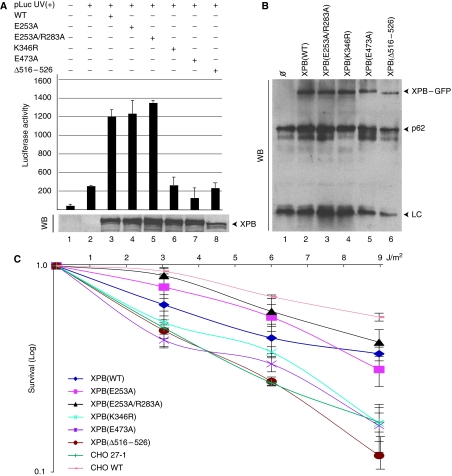Figure 3.
Analysis of the function of the new motifs in NER in vivo. (A) CHO-27-1 cells were transfected with UV-irradiated pLuc plasmid expressing the luciferase gene (lanes 2–8) in combination with vector expressing either XPB(WT) (lane 3), XPB(E253A) (lane 4), XPB(E253A/R283A) (lane 5), XPB(K346R) (lane 6), XPB(E473A) (lane 7) or XPB(Δ516–526) (lane 8). The luciferase activity in cell lysates (48 h post-transfection), normalized with the internal β-galactosidase standard, assesses repair complementation. Results are expressed as relative luciferase activity. Values represent averages±s.d. from three independent experiments. A measure of 50 μg of total extract were resolved by SDS–PAGE and western blotted (WB) with a mouse anti-human XPB antibody (Coin et al, 2004). Note that XPB(Δ516–526) migrates slightly lower than the others because of the deletion. (B) TFIIH from 100 μg of extracts prepared from untransfected CHO-27-1 (lane 1) or CHO-27-1 stably expressing XPB (lanes 2–6) was immunoprecipitated with a polyclonal antibody against the p62 subunit of TFIIH and resolved by SDS–PAGE, followed by Western blotting with a mouse anti-human XPB and a mouse anti-p62 antibody. LC; light chain of the antibody. (C) Quantitative UV-survival analysis of transfected CHO-27-1 cell lines. Results are expressed as a ratio between the cells that survived after irradiation and the cells that survived without treatment. Values represent averages±s.d. from three independent experiments.

